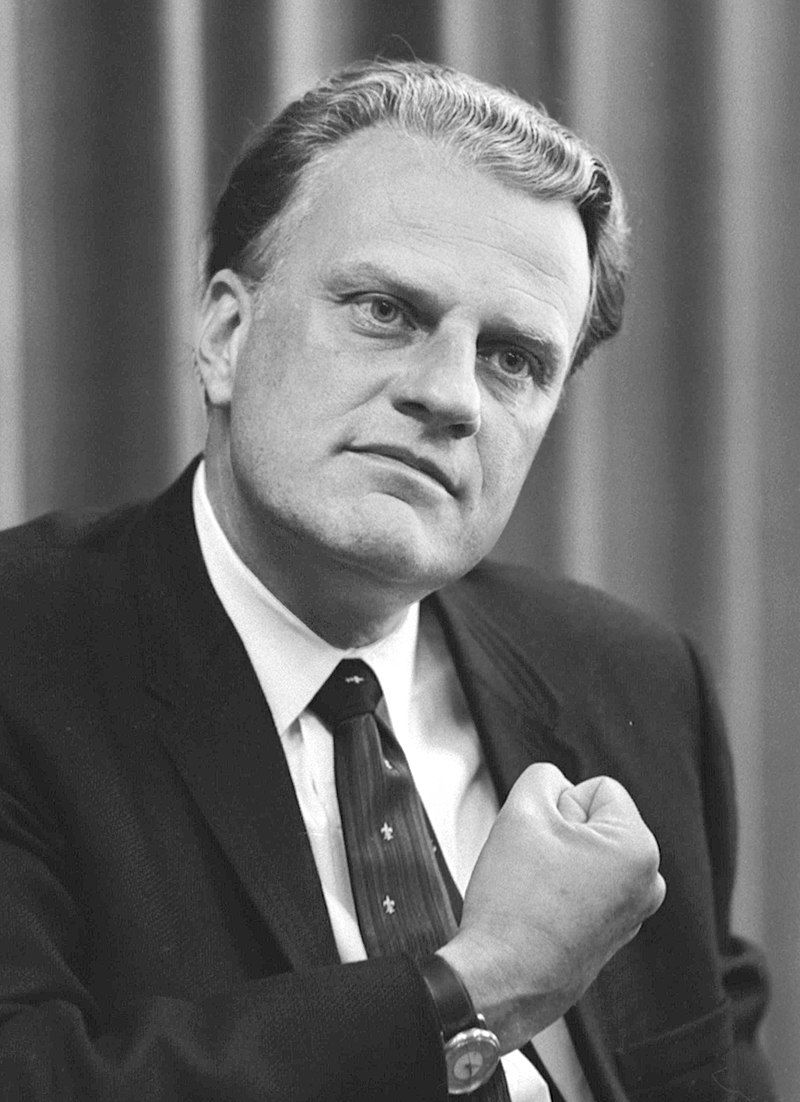[The Rev. Billy Graham, pictured here in 1966, was identified with the wing of evangelical Christianity in the U.S. that trusted in science and reason.]
The 2020 Census of American Religion, which is based on a survey of nearly half a million people, has shown that those identifying as white evangelical have since 2006 dropped from 23 percent of the population to 14.5 percent.
That revelation, together with the news that mainline Protestants, at 16.4 percent, now outnumber evangelicals, drew quite a few headlines last month and some interesting commentary.
Particularly notable in the latter category were pieces by Michelle Goldberg, in her regular column in the New York Times, and Bill McKibben, writing for the New Yorker.
They both focused on some other findings — like the fact the survey also said that white evangelicals are the oldest religious group in the nation, with a median age of 56. But, one was more pessimistic in the short term about the implications.
McKibben, prominent environmentalist author and lifelong adherent of the mainline camp, took heart and saw it as a sign of moderation in our perilous post-Jan. 6 world. He also notes that a Gallup poll has recently reported that more Americans say that they are “thriving” than at any time in the past dozen years.
On the other hand, Goldberg, who identifies as secular Jewish, sees danger up ahead. She acknowledged the “striking turnabout after years when mainline Protestantism was considered moribund and evangelical Christianity full of dynamism.”
Goldberg wrote, “Activists imagined a glorious future. ‘Home-schoolers will be inordinately represented in the highest levels of leadership and power in the next generation,’ Ned Ryun, a former Bush speechwriter, said at a 2005 Christian home-schooling convention. Ryun was the director of a group called Generation Joshua, which worked to get home-schooled kids into politics. The name came from the Old Testament. Moses had led the chosen people out of exile, but it was his successor, Joshua, who conquered the Holy Land.”
The 2020 Census of American Religion was conducted by the non-profit, non-partisan think-tank Public Religion Research Institute and Goldberg spoke with Robert P. Jones, its chief executive, who is the author of the 2016 book “The End of White Christian America.”
Goldberg continued, “‘It’s not just that they are dying off, but it is that they’re losing younger members,’ Jones told me. As the group has become older and smaller, Jones said, ‘a real visceral sense of loss of cultural dominance’ has set in.
“White evangelicals once saw themselves ‘as the owners of mainstream American culture and morality and values,’ said Jones. Now they are just another subculture.
“From this fact derives much of our country’s cultural conflict,” the New York Times columnist added, linking all of this with the rise of Donald Trump and the growth of QAnon.
“It’s not unlike a belief in the second coming of Christ,” Jones told Goldberg. “That at some point God will reorder society and set things right. I think that when a community feels itself in crisis, it does become more susceptible to conspiracy theories and other things that tell them that what they’re experiencing is not ultimately what’s going to happen.”
“I was frightened by the religious right in its triumphant phase,” Goldberg wrote in her piece, “But it turns out that the movement is just as dangerous in decline. Maybe more so. It didn’t take long for the cocky optimism of Generation Joshua to give way to the nihilism of the Jan. 6 insurrectionists. If they can’t own the country, they’re ready to defile it.”
McKibben examined the usual media narrative of American Protestantism from the Eisenhower era onward. “In this telling, the ‘mainline’ became the ‘sideline,’ as congregations fled the moral relativism of out-of-touch pastors, who replaced God’s word with liberal politics. Having been baptized a Presbyterian, grown up as a Congregationalist, and spent my adult life as a Methodist, I watched this decline close up.”
He writes, “Eventually, most white evangelical congregants tied themselves to Donald Trump—in 2016, 81 per cent of white evangelical voters chose him and, according to a PRRI poll from 2018, he had a 72-per-cent approval rating among them—despite the fact that he showed not the slightest sign of Christian understanding or behavior.” (In contrast, the PRRI survey showed that 35 percent of white mainline Protestants identify as Democrats, 33 percent as Republicans and 30 percent as independents.)
McKibben quoted his own expert in Diana Butler Bass, “an unflagging chronicler of American Protestantism who, having gone in her personal life from the mainline to the evangelical and back again, was ahead of her time, points out that for decades, the media paid no attention to these declining (and demure) denominations, concentrating instead on the provocative Falwells, Swaggarts, and Robertsons. ‘If one was born after 1980, it was hard to know that mainline Protestantism even existed,’ she writes.”
Neither Goldberg or McKibben focused at all on the growing tensions within the ranks of white evangelicals caused by the rise of Trump, something that the Economist highlighted in a report back in March (though McKibben does mention people walking away). That magazine quoted a poll that said 28 percent of white evangelicals believe in QAnon, buttressing Goldberg’s point to some extent in that regard, but adding that this, according to “numerous evangelicals” contacted by the Economist, had caused a split in their church.
Nor did either columnist make reference to the theology that outside of the South after World War II, in the words of Mark Labberton, president of Fuller Theological Seminary in Pasadena, combined “deep, biblical reflection with social engagement, careful academic scholarship and a trust in science and reason.”
The Economist summarized this position: “It tried to steer away from the literalist interpretation of the Bible, to support civic engagement and free itself from the more fundamentalist and overtly racist tendencies of its Southern cousins. One figure who became the face of the movement, and held sway in both strands, was Billy Graham.”
In his 1988 history of the civil rights movement, “Parting the Waters,” Taylor Branch says that while former Vice President Richard Nixon increasing distanced himself from the Rev. Martin Luther King Jr. after the 1960 election, Graham maintained ties behind the scenes.
“[Graham] regarded King’s gospel as his own and King respected Graham’s course professionally if not in doctrine. Although the two of them did not work together in public, they cooperated privately through their lieutenants.”








